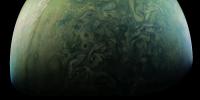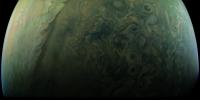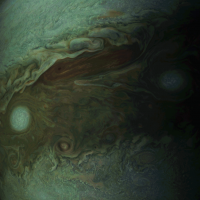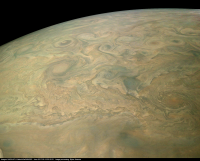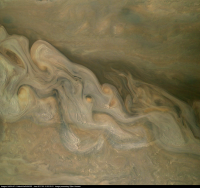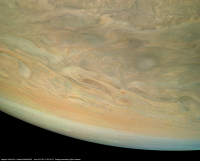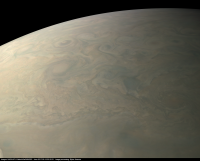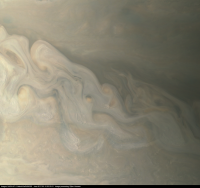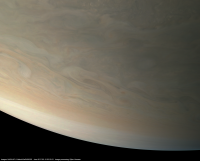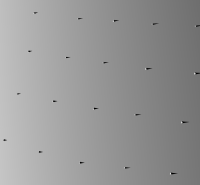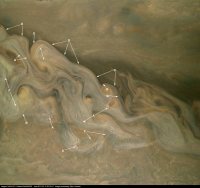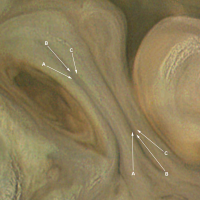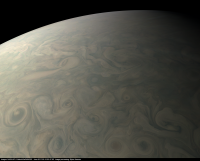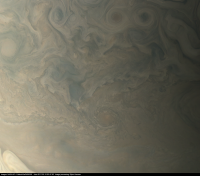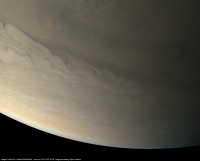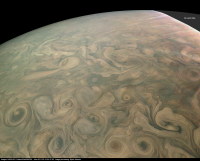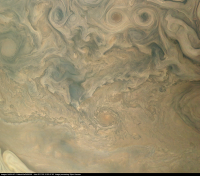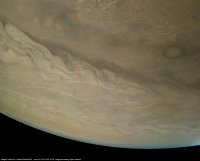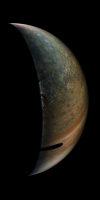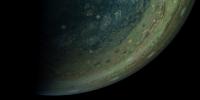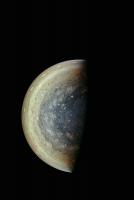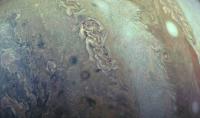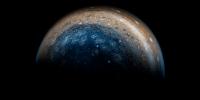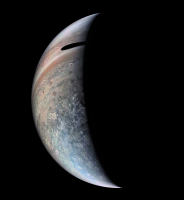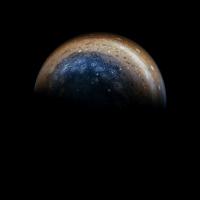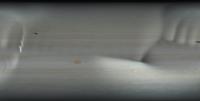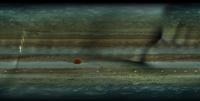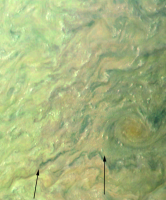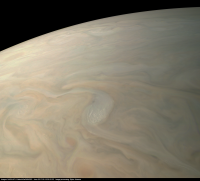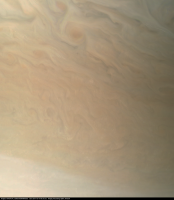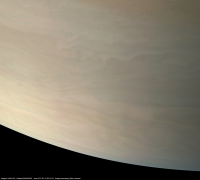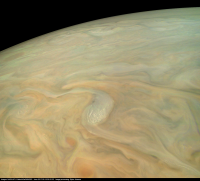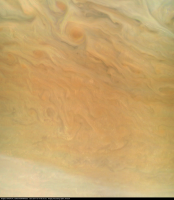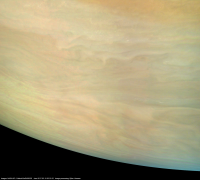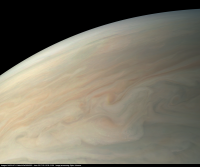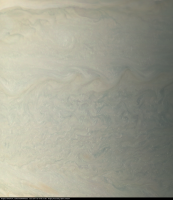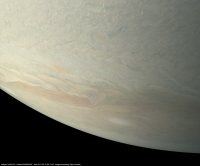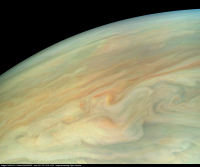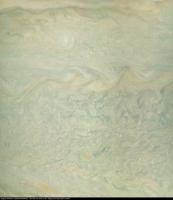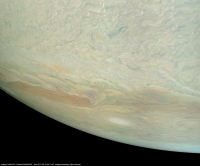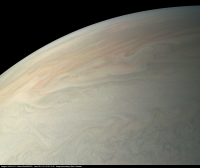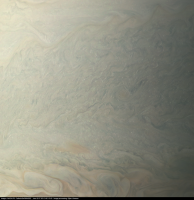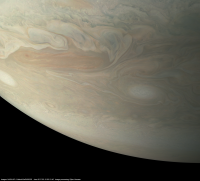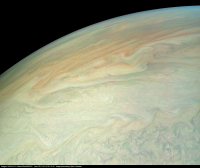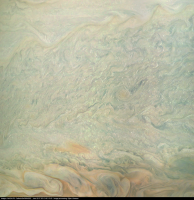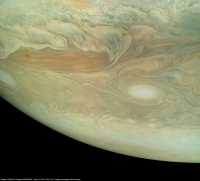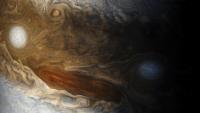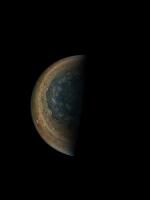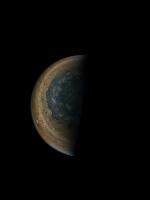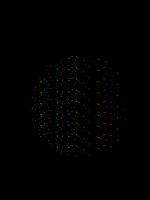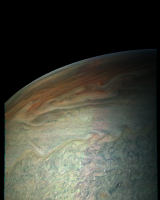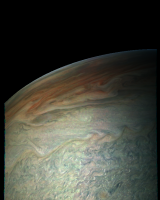Printable Version of Topic
Click here to view this topic in its original format
Unmanned Spaceflight.com _ Juno _ Juno perijove 6
Posted by: Gerald May 4 2017, 05:57 PM
https://www.missionjuno.swri.edu/junocam/voting?current started yesterday, and it will last for another almost 7 days.
This time, I'm not quite free of bias, since I'm interested in an extension of the polar time-lapse sequence, especially in a coverage of the north and south polar FFRs and the presumed edge of the respective polar haze disks. I think - well, I'm rather certain - that it's possible to infer short-time dynamics of the FFRs, and of the vortices near the edge of the haze disk. Due to the expected good contact to Earth during the PJ-6 pass we have a good chance to obtain overlapping images of these regions.
More in the discussion section on the missionjuno site. Of course, there are other interesting targets, too; see Glenn's and John Rogers' (Philosophia-47) comments.
A full latitude coverage would allow for a pole-to-pole animation.
Posted by: mcaplinger May 19 2017, 09:28 PM
Part of the PJ6 dataset has been posted to missionjuno. There were some GDS/DSN issues that are holding up the rest of it, which should be posted on Monday.
Posted by: Gerald May 20 2017, 05:47 PM
Here PJ06 images #109, #110, and #111, in a preliminary version:
It's the kind of images, I've hoped for, and it's beyond my expecatations. I hope we'll get similar images of the southern FFRs.
Posted by: Gerald May 21 2017, 01:15 AM
Another 5 PJ06 images split into 2 posts for upload limitations:
Very fascinating!
Posted by: Gerald May 21 2017, 01:26 AM
The target names in the order of the images:
JNCE_2017139_06C00109_V01: POI: Scott' polar cap
JNCE_2017139_06C00110_V01: POI: Southern Edge of Northern FFRs
JNCE_2017139_06C00111_V01: POI: Maximus Spatium
JNCE_2017139_06C00112_V01: POI: Great Polar Spot
[pending (my fault) : JNCE_2017139_06C00113_V01: POI: The Big Red Stripe]
JNCE_2017139_06C00114_V01: POI's: SPOT OF BRAHMAN, Gas irregulartiy
JNCE_2017139_06C00115_V01: POI's: Little Greenish place, HotSpot, Hot Spot Tail
JNCE_2017139_06C00117_V01: POI's: The darkest spot, A multicolored band
JNCE_2017139_06C00118_V01: POI: Belt-Zone border
Posted by: xflare May 21 2017, 09:36 AM
Looks like there are hundreds of individual storm cell clouds in that last image !!!
Posted by: Gerald May 21 2017, 05:40 PM
http://junocam.pictures/gerald/uploads/20170521/.
For these images, I fixed two known flaws in my image enhancement subroutine.
I'll upload them to the missionjuno site later today.
Posted by: scalbers May 21 2017, 07:14 PM
New wonders to behold on Jupiter. I like this section of Gerald's collection with the array of round circulations:
Posted by: Sean May 21 2017, 08:56 PM
Gerald's excellent work with some processing tweaks...repairs, levels, high pass overlay
https://flic.kr/p/UPXJ5z
https://flic.kr/p/UYcmrJ
Posted by: Sean May 22 2017, 12:59 PM
After NASA / SwRI / MSSS / Gerald Eichstädt
Image processing: edge filters, repairs & levels
https://flic.kr/p/UsU1Bq
and a sequence...level boost & sharpening, no repairs.
https://flic.kr/p/Ut35bo
Can't wait to see the movie on this Gerald!
Posted by: Sean May 22 2017, 04:53 PM
Last one... my favourite image from the latest sequence with many repairs, a blended high pass overlay and blended levels pass.
https://flic.kr/p/V4q8K4
Posted by: mcaplinger May 22 2017, 05:46 PM
Beautiful work. Maybe someone could take a run at correcting the color manually. I can't really publicize this as is because I'll have to field too many questions about why it's so green.
Posted by: JRehling May 22 2017, 05:51 PM
That's great, Sean. It almost induces vertigo, which is high praise indeed!
Posted by: Sean May 22 2017, 06:25 PM
Thanks but all credit to Gerald for the work he has put into producing these images.
My focus was much less on color than it was on the details in the image.
**I've updated the following with more repairs**
Here is a version without the green cast... I tried to be modest but I have a version either side which might suffice also.
https://flic.kr/p/TM4q3j
...and the same correction applied to the sequence...
https://flic.kr/p/V13Xk7
&
https://flic.kr/p/V14wFL
https://flic.kr/p/TM6TC5
https://flic.kr/p/UtuknU
Posted by: Gerald May 22 2017, 08:44 PM
Seán, you deserve credit for fixing my shortcomings. My means are limited, so your help is well appreciated.
Posted by: jccwrt May 22 2017, 11:56 PM
I tried my hand at processing some of Gerald's images. The scaling is a little weird on these, as I squeezed the image horizontally to fit the horizon to a circle, and then resized to 1920x1200 for use as a wallpaper. The original JunoCam images have enough artifacting and noise that I don't think there's much change in the amount of detail. I used the HLVG plugin for Photoshop to remove the greenish cast to the images, and then used the lightest-toned clouds to set the gray point of the image. The results look qualitatively pretty similar to processed Cassini images of Jupiter, so I'm happy.
https://flic.kr/p/V52V7X
https://flic.kr/p/UtTPCq
Posted by: Explorer1 May 23 2017, 12:57 AM
First science result press conference on Thursday (11:00 PST): https://www.missionjuno.swri.edu/news/nasa-to-discuss-results-from-juno-mission
Posted by: mcaplinger May 23 2017, 03:23 AM
Everyone who's processed images from PJ6 (Sean and Justin in particular), if you could upload your images or your favorite subset to missionjuno, Candy Hansen is currently at a Juno science team meeting and would like to highlight your work. Gerald's are obviously there already.
Posted by: Gerald May 23 2017, 08:39 AM
Most of the remaining PJ06 close-up raws are on the mission site by now. So, I had a long night with processing these.
I've modified the red/green ratio from 0.82 to 0.88 for http://junocam.pictures/gerald/uploads/20170523/.
Images #122 and #123 have bad reddish pixels due to some yet unidentified over- or underflow.
I'm not yet sure, how long it will take to fix this software issue. If someone likes to post-process the images, especially the two flawed ones, feel free to do so.
I'll upload the new images to the missionjuno site except #122, #123, and #142. The latter shows greenish portions due to partial CCD saturation.
(I'll notify Candy directly via email, before uploading.)
Before rendering a full movie, I'll first need to find and fix the software issue. In the meanwhile, I can adjust the color weights for the movie according to your wishes. This week, I've only later today, Wednesday and Thursday time for movie renditions. So, I'm not yet sure, whether I'll be able to complete a full pole to pole flyby animation with 125-fold time lapse this week. But I'm confident to able to render some fragments, at least. I'll start rendering the approach sequence for the northern half in about 12 hours, even if the software flaw won't be removed, and hope, that it won't show up in this part of the sequence.
Posted by: Ant103 May 23 2017, 11:30 AM
Hi ![]()
Those Junocam pictures processed by you, Gerald, are very inspiring ![]() And excellent work everyone !
And excellent work everyone !
Some of my takes on your wonderful work. I have increase the exposure, balanced the colors and sharpened a little. On the full disk Jupiter image, I added some soft light effet to match the feeling we can have by watching at the gas giant with a telescope.
What I love here is that we are seeing actual cumulo-nimbus clouds, the clouds that are forming cells of thunderstorms.
http://www.db-prods.net/blog/wp-content/uploads/2017/05/JNCE_2017139_06C00112_V01-raw.bmp_reproj_30px_30.2800s_cx818.0000000_enh1.bmp_sphC__03.jpg
This image was processed to have a view we can have if we had a 50mm lens (I had to reproject the cylindrical image into rectilinear).
http://www.db-prods.net/blog/wp-content/uploads/2017/05/JNCE_2017139_06C00113_V01-raw.bmp_reproj_30px_30.2800s_cx830.0000000_enh1.bmp_sphC_2.jpg
And a full disk Jupiter ![]()
http://www.db-prods.net/blog/wp-content/uploads/2017/05/JNCE_2017139_06C00124_V01-raw.bmp_reproj_30px_30.2800s_cx813.0000000_enh1.bmp_sphC_.jpg
Posted by: Sean May 23 2017, 01:53 PM
I've started uploading to the Mission Juno site.
Here is the first portrait from Gerald's latest batch.
Repairs/Edge filters/Levels/Masks/Colors
https://flic.kr/p/V62rE6
Thanks again for your efforts Gerald... beautiful to look at and to work with.
Posted by: jccwrt May 23 2017, 02:51 PM
I've uploaded my images there now, thanks for the heads up!
Posted by: Sean May 23 2017, 03:06 PM
Another portrait from Gerald's latest...
https://flic.kr/p/UTtyvX
Jupiter is just showing off now... quite unseemly.
Detail...
https://flic.kr/p/UTyiee
https://flic.kr/p/TNKyPS
https://flic.kr/p/UTyfVr
Posted by: Sean May 23 2017, 04:51 PM
A third portrait from Gerald's latest...
https://flic.kr/p/TRLp12
Details...
https://flic.kr/p/V6jUAr
https://flic.kr/p/TRLppi
https://flic.kr/p/UTDjmV
Posted by: The Singing Badger May 23 2017, 05:21 PM
These images are absolutely incredible. It's amazing to see at last the fine texture of the cloudscapes. For me, this is the first time Jupiter has ever looked like a place, rather than an abstract painting.
Huge, huge, respect to all whose work has contributed to these images!!
![]()
Posted by: Sean May 23 2017, 06:57 PM
Thanks Badger! ![]()
Here is the last one for today...
https://flic.kr/p/Uvmjbu
Alternate comp...
https://flic.kr/p/UvmmuY
Detail
https://flic.kr/p/V6wnPc
Sequence of the 4 uploaded today...
https://flic.kr/p/TP2yaJ
Posted by: GS_Brazil May 23 2017, 10:52 PM
Huge, huge, respect to all whose work has contributed to these images!!
So now all these people ( including myself ) that were a bit disappointed with the Juno images finally have to take their words back.
Also amazing to see how some higher clouds / layers throw shadows on lower layers.
Posted by: Sean May 23 2017, 11:36 PM
PJ06 sequence
https://flic.kr/p/TSiEmk
Added a couple more shots to fill it out.
Posted by: belleraphon1 May 24 2017, 12:26 AM
These are phenomenal.... really feel I am seeing the planet now for first time. Cannot take my eyes off the details.
Thanks to Junocam team and all the incredible image magicians out there.
Craig
Posted by: jccwrt May 24 2017, 02:28 AM
Here's my effort at processing image #123 using Gerald's version as a base.
https://flic.kr/p/UUrG3P
Posted by: Ron Hobbs May 24 2017, 02:37 AM
AWESOME!!!
Posted by: Sean May 24 2017, 10:40 AM
PJ06 cloud detail
https://flic.kr/p/V48FGA
Posted by: antipode May 24 2017, 11:53 AM
I cant believe Junocam was an 'add-on'. These 3D effects with the deep shadows and high icy 'pileus-like' cloud caps are beyond spectacular.
Congrats to all the image wizards - I cant stop staring.
P
Posted by: GS_Brazil May 24 2017, 12:38 PM
What's the size of these 'pileus-like' cottonwool clouds?
Posted by: mcaplinger May 24 2017, 03:45 PM
Great question. It's fairly easy to figure out from the metadata, but I'm not sure which image this is from or whether any scaling has been done. If you have the altitude from the metadata, then the pixel scale of Junocam at nadir is just 673e-6*altitude in whatever units the altitude is. Of course, farther away from nadir the scale goes down because the range is larger.
I'm amazed at these products. To be honest, we didn't know that half this stuff was in the images ourselves. I hear there was a lengthy discussion about the small clouds at the science team meeting yesterday.
If I could make one suggestion, it would be to include the image identifier somewhere for reference along with every processed image. I prefer the shorthand notation (e.g., pj6-137) instead of the long-winded image ID ("JNCE_2017139_06C00137_V01") that appears in the metadata, but the latter is the official name.
Posted by: Sean May 24 2017, 04:32 PM
I will be sure to include that info for the next batch.
I was hoping to be able to edit the image details when posting to MissionJuno but that functionality doesn't seem to exist...or am I missing something?
Posted by: Gerald May 24 2017, 05:57 PM
For http://junocam.pictures/gerald/uploads/20170521/, I'm extracting the image number out of the file name, and use it as small caption above each thumbnail. I do also try to use the original file name as a substring of the file name of the processed image. The raw file names, and (usually) the MSSS products, too, contain the product id as a substring in the file name. You also find the product identifier in the metadata (json) files provided in the JunoCam uploads on the missionjuno site.
And, btw., thanks to all of you who help to process these fantastic PJ06 images, or help to encourage those who do the processing! ![]()
Posted by: mcaplinger May 24 2017, 06:21 PM
There's a way of indicating the source image when you submit, but I've never submitted anything so I don't know how it works.
You could always put a label on the image if there's a good place to do so, but it does interfere with the aesthetics.
Posted by: mcaplinger May 24 2017, 06:50 PM
The image above is from PJ6-0113 from an altitude of 5110 km. The clouds are typically about 5-6 pixels in diameter in raw images, which at nadir would be 5.5*673e-6*5110 = 19 km. This is off-nadir somewhat and I'm too lazy to do the geometric processing, but that's a rough order of magnitude -- 20-40 km.
Posted by: Sean May 24 2017, 07:40 PM
Since working with this data I have refined my processes a little and managed to eke a little more detail.
First frame is the raw image from Gerald. Second image is what I uploaded yesterday. Third image is current work in progress so it hasn't been 'repaired' of any registration marks or hot pixels.
Gif compression doesn't do it any favours of course but there is a marked improvement.
**updated**
That gif was terrible... here is a pic
https://flic.kr/p/V8rYVT
Thanks again for all your efforts Gerald. I hope you are enjoying all the derived images.
Posted by: Gerald May 24 2017, 08:35 PM
You could always put a label on the image if there's a good place to do so, but it does interfere with the aesthetics.
There is a specific edit field in the lower left of the submission dialog.
When creating labels on the image, it's difficult for release in the NASA Photojournal or as an image of the week. You'll be contacted and asked to provide a version without annotations or labels in case your image is selected for these purposes.
@Seán: I'm enjoying the derived products very much, and am happy to learn about options for improvements. Currently, I'm rendering a 125-fold 25fps PJ06 flyby movie of scheduled 1min36sec, however a version with cuts when switching to the animation of the next raw image. I hope, Mike can forgive me one more time.
I'm intending to create one or more revised versions in a few weeks.
I'll likely be offline between Friday and Sunday, so I hope, that the movie will be completed and uploaded tomorrow in the evening (CEST) resp. in the morning (PDT).
Posted by: Sean May 24 2017, 09:40 PM
I would love to have a go at processing the P06 animation when it is finished. ( with uploaded frame sequence like P05? )
I am still working with P05 animation and applying what I have learned making P06 & P04 images to that sequence.
Here is an example of P05 stills I have upscaled to 1080x1920...
https://flic.kr/p/TQwivD
https://flic.kr/p/USpyMc
The idea is to get the P05 animation to this standard.
It is very promising but a lot of work to smooth or disguise the sudden exposure shifts, some overlapping frames would be useful of course but I do appreciate how time consuming it must be to render these frames.
Posted by: jccwrt May 24 2017, 10:39 PM
Processed image #117, centered over the southern edge of the South Equatorial Belt. The belt is kind of messy from block artifacting, but the jet marking the southern boundary of the belt and adjacent South Tropical Zone are much more clear.
https://flic.kr/p/UT96vJ
Some features of interest. Here's another example of probable convection and associated clouds located along the turbulent boundary between the South Equatorial Belt and South Tropical Zone:
https://flic.kr/p/UW1gut
We've seen from Sean's excellent processing image #118 centered on the South Tropical Zone that there's a lot of these convective-type features. Seeing many of the same clouds in this more oblique image. There's hints of cloud shadows as well, and given that those shadows look detached from the convective cells, these may be actually occurring well above the surrounding zone clouds:
https://flic.kr/p/TTZEb4
https://flic.kr/p/TTZEcg
Posted by: Bjorn Jonsson May 25 2017, 12:51 AM
I never thought I'd say this about any of the JunoCam images but: The PJ-6 images are the most spectacular images of Jupiter I've ever seen. I was aware that the JunoCam images would be better than lots of people expected (and the Earth flyby images hinted at this) but this is far beyond my wildest expectations.
There are interesting details just about everywhere that are not present in earlier images of Jupiter or they are visible - but not with the same clarity as in the Juno images. This is especially true of the small whitish clouds (and they seem to be much more frequent than earlier images suggested). The same can be said about cloud shadows and vertical structure - I think Juno has been able to directly image the elevation difference between bigger clouds, e.g. dark and light clouds.
Here are my versions of PJ-6 image 112 (observation name: "POI: Great Polar Spot"). They are not based on Gerald's images, however his images were very useful as a 'sanity check'. I'm especially impressed by how fast he's able to churn out high quality image products - it takes me far more time.
And here are the images, first a version where global illumination has been removed, the contrast has been exaggerated and small scale features have been sharpened with an unsharp mask:
And an approximately true color/contrast version:
Posted by: Explorer1 May 25 2017, 02:25 AM
Astounding work, Bjorn (and everyone else!). Straight out of a Clarke novel... and now I've got Holst on the headphones.
And to think this camera nearly didn't make it on board (and every planned mission after Juno focuses heavily on the moons). It's the GRB's turn next perijove, right?
Posted by: J.J. May 25 2017, 03:49 AM
Can only echo thanks to the Juno team and to everyone else working on and supplying this astounding imagery.
My jaw has literally been hanging open this whole thread.
Posted by: Sean May 25 2017, 03:22 PM
I have updated the following portrait from Perijove 06
https://flic.kr/p/UUjFT5
https://flic.kr/p/V9KGaB
https://flic.kr/p/V9KFEP
Excellent work by Bjorn & Justin!
So great to see Jupiter at this level of detail... I will endeavour to tread gently.
Posted by: Bjorn Jonsson May 25 2017, 05:14 PM
As I mentioned previously, these latest JunoCam images are awesome. I took a fairly detailed look at one of the images I posted earlier with particular attention to cloud elevation differences. First an unusual image. This is a perfectly flat DEM with several spikes - their shadows show the direction of sunlight in one of the JunoCam images I posted earlier:
And here is the corresponding JunoCam image. This is one of the images I posted earlier but here I have added some annotations:
A. Bright, high altitude clouds that usually seem to be isolated or to occur in small clusters.
B. These clouds are similar to (A) in color and altitude. But unlike (A) they appear elongated, probably parallel to the wind direction. At least in some cases they indicate high wind speeds - clouds like these are visible at lower resolution in Voyager images showing the northeast periphery of the Great Red Spot where the wind speed is very high.
C. I suspect that here we are seeing the darker and lower cloud deck through tenuous and mostly transparent high altitude clouds. This is more obvious when looking at the red channel only.
D and E. Here JunoCam may have directly observed/imaged the elevation difference between the dark clouds and the less dark clouds south of the 'color/brightness transition'. Areas indicated by (D) appear slightly darker than areas indicated by (E). When taking into account the direction of the shadows in the DEM/spike shadow render above, the areas indicated by (D) may be in shadow caused by the brighter clouds south of the brightness/color transitions while the areas indicated by (E) are not in shadow.
F. These clouds seem somewhat similar to (A) but they occur in far bigger clusters. Apparently they also might be at a slightly lower altitude - this is not obvious though.
G. Possible shadows hinting at elevation differences but color/brightness variations are also a possibility. Features like this are very common.
Posted by: scalbers May 25 2017, 05:33 PM
Superb image processing and analysis. Great to see both enhanced and unenhanced/realistic versions to get the complete picture. Some first reactions - if I have the larger scale context right:
The dark areas next to D/E look like the IR hot spots at the edge of a belt.
The shadow in D agrees with my subjective impression of the brighter laminar appearing clouds being higher and overlaying the darker adjacent clouds.
G looks like cloud brightness variations to me. These narrow strands look similar even in differing orientations?
"A" features clearly have high cloud tops. I wonder if their bases are low enough to tap into the water vapor layers, helping to give enough opacity to yield the brighter white color. The more true color images suggest these tops may still be below some of the high altitude haze. This haze is yet thin enough to have distinct shadows visible. It seems there's a narrow range of haze optical thickness that allows this type of visibility.
Posted by: Gerald May 25 2017, 07:47 PM
For completeness, a few hours ago I've uploaded http://junocam.pictures/gerald/uploads/20170525/, after fixing the overflow for saturated pixels.
The first version of the PJ06 flyby animation is completed, too. It's now mostly a matter of upload bandwidth. I'll try an upload to youtube, as well as a first subset of zipped stills to the junocam.pictures webspace, and intend to provide links in about two or three hours. The zipped stills will be 2.34 GB, more than I can upload before next week.
Posted by: jccwrt May 25 2017, 09:54 PM
A. Bright, high altitude clouds that usually seem to be isolated or to occur in small clusters.
B. These clouds are similar to (A) in color and altitude. But unlike (A) they appear elongated, probably parallel to the wind direction. At least in some cases they indicate high wind speeds - clouds like these are visible at lower resolution in Voyager images showing the northeast periphery of the Great Red Spot where the wind speed is very high.
C. I suspect that here we are seeing the darker and lower cloud deck through tenuous and mostly transparent high altitude clouds. This is more obvious when looking at the red channel only.
D and E. Here JunoCam may have directly observed/imaged the elevation difference between the dark clouds and the less dark clouds south of the 'color/brightness transition'. Areas indicated by (D) appear slightly darker than areas indicated by (E). When taking into account the direction of the shadows in the DEM/spike shadow render above, the areas indicated by (D) may be in shadow caused by the brighter clouds south of the brightness/color transitions while the areas indicated by (E) are not in shadow.
F. These clouds seem somewhat similar to (A) but they occur in far bigger clusters. Apparently they also might be at a slightly lower altitude - this is not obvious though.
G. Possible shadows hinting at elevation differences but color/brightness variations are also a possibility. Features like this are very common.
Going to make some interested-layman interpretations of the meteorology here.
One observation is that the two largest A-type clouds seem to be found at eddy inflection points, right where the white clouds meet the brown clouds. I wonder if these might be supercell-like convective systems that are popping up along the boundary of white and brown clouds, and whose development is aided by favorable upper level conditions created by air diverging as it rounds the inflection point of the eddy.
F-type clouds seem to be more embedded within the local flow and are vaguely oriented in "streets" parallel to the flow direction. These are kind of reminiscent of the cloud streets that tend to form in the dry slot of a mature low-pressure system, or in clusters of multicell convection in strong upper level wind regimes where the updrafts tend to form trains.
B-type clouds look like cirrus streaks formed getting blown off the tops of the more intense convective clouds, and if you look closely at the A-type cloud clusters near the center of the image, you can see some of these streaks beginning to form as elongated cloudtops on individual convective cells.
Maybe a more clear example of what Bjorn is getting at with point C can be seen just to the right of the F at left center. There is an extremely dark brown cloud rotating around the top of the eddy that has an apparently sharp edge, but if you look closely you can see that it continues underneath the lighter clouds. (Not at a computer where I can highlight this but if anyone is having issues seeing what I'm talking about I'll try to have something up within a day)
Posted by: Gerald May 25 2017, 10:09 PM
PJ-06 flyby movie, first release:
- https://youtu.be/fKN4_RVfB2A
- http://junocam.pictures/gerald/uploads/20170525/pj06_movies/jnc_pj06_xxx_16px_45x80_timelapse125_enhance_v01_rot90_v09.avi (37 MB)
- http://junocam.pictures/gerald/uploads/20170525/pj06_movies/jnc_pj06_xxx_16px_45x80_timelapse125_enhance_v01_rot90_v09.mov (600 MB).
Posted by: Sean May 26 2017, 03:43 AM
Another updated portrait...
https://flic.kr/p/V7cjM3
Details...
https://flic.kr/p/UY6Knv
https://flic.kr/p/V7cknG
https://flic.kr/p/UY6JVi
Posted by: Gerald May 26 2017, 04:11 AM
Stills of PJ06 flyby animation, zipped:
- http://junocam.pictures/gerald/uploads/20170525/pj06_movies/jnc_pj06_flyby_v1_part12.zip
- http://junocam.pictures/gerald/uploads/20170525/pj06_movies/jnc_pj06_flyby_v1_part11.zip
- http://junocam.pictures/gerald/uploads/20170525/pj06_movies/jnc_pj06_flyby_v1_part10.zip
- http://junocam.pictures/gerald/uploads/20170525/pj06_movies/jnc_pj06_flyby_v1_part9.zip
- http://junocam.pictures/gerald/uploads/20170525/pj06_movies/jnc_pj06_flyby_v1_part8.zip
The remaining parts 1 to 7 scheduled for Monday...
Posted by: Sean May 26 2017, 01:27 PM
Here is a preview of the sequence Gerald shared... upscaled, rotated and put through a 12 step batch process.
Click thru for a video...
https://flic.kr/p/UVZbSW
I extended the length of the content x3 and I'm still deciding how to blend between jump cuts as well as tracking the full crescent to avoid linear cuts.
Posted by: ChrisC May 27 2017, 04:07 AM
Scott Bolton said "around 50 km" several times during the press conference. So, about the size of a major US city's metro sprawl, and twice as big as the average thunderstorm on Earth.
Posted by: Bjorn Jonsson May 28 2017, 04:25 PM
From the image it is not clear to me exactly what this is - brightness variations, differences in cloud altitude or even both. What I had in mind is illustrated in more detail below. This is a section of my original image enlarged by a factor of 3:
A. Slightly darkened. Tilted away from the sun?
B. Slightly brighter than A and slightly darker than C. Elongated depression / 'trough'?
C. Slightly brightened. Tilted towards the sun?
These elongated features are parallel to each other roughly in the the NNW-SSE direction. By looking at similar features with a different orientation I'm not sure which interpretation is correct. If these features are brightness variations B should always be present whereas A and C would only be present when the orientation is not too far from N-S.
Posted by: Gerald May 28 2017, 07:26 PM
http://junocam.pictures/gerald/uploads/20170525/pj06_movies/.
I hope, that I didn't overlook some of the stills. It should be 2401 images. for a total of 96.04 seconds with 25 fps.
Posted by: stevesliva May 29 2017, 06:30 PM
The seeming relief-- maybe call it drop shadowing-- at the belt edges in Sean's post #53 is just beautiful.
Posted by: Sean May 30 2017, 05:45 AM
Here is the full sequence of Perijove 06 based on Gerald's animation.
Click thru for the video...
https://flic.kr/p/V6DHjr
Upscaled to 1080, Uptimed variably x6, Processed x12
I tried to correct the linear paths the camera took & there were missing frames toward the end when compared with Gerald's original video.
Uptiming this has resulted in emphasizing the texture jump cuts which I have tried to disguise as best I could. I decided in favour of spending more time on the sharpest areas so I omitted a short area on the equatorial which warped badly when trying to find vector paths for displacing pixels. I might come back to this when I have more time.
**update**
Here is a version with Gerald's original timing & path fix...
https://flic.kr/p/UHJoBY
...and a x2 retimed version...
https://flic.kr/p/Vj2EWt
Posted by: Sean May 30 2017, 07:06 PM
125 Megapixel upscaled & refreshed Print portrait of Gerald's PJ06_123...
https://flic.kr/p/VfYvq9
Posted by: Candy Hansen May 30 2017, 10:07 PM
These are simply heart-stopping beautiful! Thank you all so much - I hope you have enjoyed seeing your work in all the press coverage of Juno last week.
https://flic.kr/p/V7cjM3
Details...
https://flic.kr/p/UY6Knv
https://flic.kr/p/V7cknG
https://flic.kr/p/UY6JVi
Posted by: Gerald May 31 2017, 08:07 AM
Candy, I'm glad, that with PJ6 we've been able to provide unexpectedly fantastic images just in time for a press briefing, which has been scheduled independently. This has only been possible in time and in this quality, with a dedicated virtual image processing team forming spontaneously, and with a camera of outstanding quality and performance, including the highly precise work of the Juno nav- and ops teams, and many more people and institutions who are equally important, but mentioned only occasionally.
Posted by: Sean May 31 2017, 10:41 AM
I would like to reiterate what Gerald said, as well as mark appreciation for his efforts in interpreting the data & creating the products I use. It has been an interesting week and a particularly intense 48 hours fielding questions. I have also realised how much I have to learn with respect to image processing.
Now, I'm looking forward to what we get from Perijove 07!
**rolls up sleeves**
Posted by: Gerald May 31 2017, 05:51 PM
I think, the #124 sequence is missing. I've added this to http://junocam.pictures/gerald/uploads/20170525/pj06_movies/.
Did you find any other gaps? The video should be 1:36.04 with 25fps, a total of 2401 frames.
Posted by: Sean May 31 2017, 08:06 PM
Thanks Gerald.
I started looking at the cylindrical maps you provided for PJ04 & wondered if you could produce them for PJ06? I am working to blend these separate maps into one with total perijove coverage.
**update**
If you have the time of course, I suspect this might not be the case! ![]()
Did you find any other gaps? The video should be 1:36.04 with 25fps, a total of 2401 frames.
Posted by: Bjorn Jonsson May 31 2017, 11:12 PM
The Great Red Spot! PJ-7 should be very interesting.
Posted by: Gerald Jun 2 2017, 12:10 AM
I understand, what you are intending to do. I'll try to create an enhanced global seamless cylindrical PJ06 map with some constraints I need to consider. Give me a week or so.
Posted by: antipode Jun 2 2017, 02:07 AM
Sean
I assume this is your work?
https://www.youtube.com/watch?v=3kQbTBt418o
Great to see it in a manageable size and of course the subject DEMANDS the use of the Ligeti.
Plus its getting an audience - nearly 80000 hits!
This clip needs to be shown on every 6pm news service - it might help put things in some perspective.
Congratulations!
P
Posted by: Sean Jun 2 2017, 09:32 AM
Much appreciated Gerald. I've also started looking into reprojection to fill in gaps using previous observations... the theory works, i just need to get good at it!
Thanks P, Yes I made that and I'm glad you appreciate the use of Ligeti. Its not everyones cup of tea. Someone left a note saying 'Jupiter is a planet NOT a horror film!' ![]()
I have a prototype version slowed down by a factor of 10...so a 12 second closeup sequence lasts 2 minutes and it is very effective.
Posted by: JRehling Jun 2 2017, 02:42 PM
Sean, the video is amazing, and it looks like there is a wealth of stereo information to be extracted. I'm almost certain that we see significant changes in parallax at many times and places throughout it.
Posted by: Gerald Jun 2 2017, 03:08 PM
Seán, Charley Locke just notified, that she completed her https://www.wired.com/2017/06/juno-jupiter-video/.
I wondered, whether she would write a technical article with all the material I provided her, but I think this would have taken several days, at least.
Regarding parallax: I tried to identify parallax effects since the first Jupiter flyby, but wasn't able to find some, thus far, in an unambiguous way. There is some tiny displacement for high velocity jets which could be confused with parallax. But the projection isn't quite perfect, so you get some artifacts from processing inaccuracies, too.
Scroll down a bit https://www.britastro.org/node/8427 to see some animations.
We see such tiny displacements in all perijoves with close-up images.
Posted by: Sean Jun 2 2017, 03:24 PM
@JRehling Thanks, I would be careful about reading too much into the videos I make since I am adding a plethora of tween frames which are not reliable sources to scrutinise.
@Gerald...yes I was notified also. I provided a LOT of information which was not used so I wonder if the initial brief was changed. Is this typical of the media? I suspect so.
I also had to insist that they remove a version of the video which was appropriated by someone else, re-compressed and a different soundtrack added. This version of the video did not attribute credit to either of us.
The same thing happened when a picture editor applied some awful processing to my images and credited ME with the work! Not only destroying the work ( whatever its merits ) but conflating his image with mine and trashing my reputation into the bargain. He did it twice.
I have to say that wilful appropriation compounded by lackadaisical editorial is extremely difficult and time consuming to counter. Jupiter deserves better!!
Posted by: Gerald Jun 2 2017, 04:17 PM
I've terabytes of processed JunoCam images, but I've released only a few gigabytes. That's similar with the media. They pick out what they consider most interesting for their audience. Might be, WIRED will publish a more detailed article at some time, later.
As soon as something is released publicly, I occasionally check how it is used elsewhere, but I usually don't try to intervene. I just try to learn how to stay clear enough not to cause unintended misinterpretations myself.
What counts, is that your videos are going to get broad attention. This helps public outreach, and it provides a more complete perception of Jupiter, the Juno mission, and the high quality of JunoCam in the public. I'm confident, that at the end, the web community will pay most attention to the best video products.
Posted by: avisolo Jun 3 2017, 01:06 AM
As soon as something is released publicly, I occasionally check how it is used elsewhere, but I usually don't try to intervene. I just try to learn how to stay clear enough not to cause unintended misinterpretations myself.
What counts, is that your videos are going to get broad attention. This helps public outreach, and it provides a more complete perception of Jupiter, the Juno mission, and the high quality of JunoCam in the public. I'm confident, that at the end, the web community will pay most attention to the best video products.
Thanks for your awesome work Gerald! Here is my take on your Jupiter flyby animation video, featuring Holst's Jupiter suite, Carl Sagan voiceover and real Jovian sounds:
https://vimeo.com/220084865
Posted by: Gerald Jun 3 2017, 01:33 AM
Very nice, avisolo! I knew, that there are people out there who are much better than me in creating and adding sound tracks. Thanks a lot!
Posted by: PFK Jun 3 2017, 08:40 AM
Absolutely astonishing stuff; I'm in awe! No problem with Ligeti either, though as an experiment I opened a 2nd youtube window and loaded a track someone put on a while back when "stretching" music became a fad.
https://www.youtube.com/watch?v=1v_Y424BWRM
is Holst's Jupiter slowed 400 times. So if you start that 8:50 in (important!), at the same time as starting your epic (sound off), and hit the volume button with yours on full screen...well the result is interesting I think!
Posted by: Sean Jun 3 2017, 10:51 AM
@PFK... It's been a fascinating online discussion regarding the music choice and having a traditional classical soundtrack is certainly what most people expect. Seeing Jupiter like this was truly mind blowing so it seemed appropriate to lean toward something exotic. Having such a strong reaction for/against is a good indicator!
Posted by: avisolo Jun 3 2017, 12:46 PM

The 2001 OST choice is cool but might freak some parents out when showing Gerald's animation to their young children. I went with Holst's Jupiter movement from his Planets suite - let's see how it affects the reception:
https://vimeo.com/220084865
BTW I have a Techno version in the works:)
Posted by: JRehling Jun 4 2017, 12:17 AM
In studies/metrics of human visual perception, there are well-known geometric circumstances that can yield higher resolution than other circumstances. For example, it is much, much easier to tell if a line has a horizontal displacement of size s in it (-------_______) than it is to determine if two lines have a difference of size s in their lengths.
Looking at the Juno video, I wondered if there is something like that which could elucidate cloud heights. For example, if a higher cloud casts a shadow on a lower cloud, a single image may leave it ambiguous whether this is really a shadow as opposed to a dark curvilinear feature in a flat cloud deck. However, if it is a relief feature, then it should disappear when viewing the same region from the sunward direction. And even if it is not resolved very well, its apparent intensity should change as viewing perspective changes so as to emphasize or hide the shadow.
The geometry of Juno's pole-to-pole passes might provide some very good opportunities to test this in the polar regions… not so much nearer the equator.
Posted by: Gerald Jun 4 2017, 06:34 AM
I'm using this effect for calibration purposes down to below 1/100 of a pixel, better than the human eye can perceive. But it doesn't resolve ambiguities between motion and parallax in a straightforward way.
The geometry of Juno's pole-to-pole passes might provide some very good opportunities to test this in the polar regions… not so much nearer the equator.
This might work for the small white cumulus-like clouds, but I didn't verify this yet. But in the more general settings, reality is more tricky than it might look at first glance. Jupiter's appearence changes in a non-trivial way with solar incidence and emission angle due to light scattering and absorption. I'm going to analyse this effect in very detail. Might be, that a residual effect of shadows can be separated. If I'll get reliable results that way, I would need to deliver this to the Juno team first, in order to check for publishable science. I'll try to provide first results http://www.epsc2017.eu/information/deadlines_and_milestones.html in any case, http://www.epsc2017.eu/information/general_information.html.
Posted by: avisolo Jun 4 2017, 04:17 PM
WHOA this seems to be getting a lot of views and likes!
https://vimeo.com/219216194
Posted by: Sean Jun 7 2017, 10:15 AM
Here is an update on processing Gerald's animation for PJ06...
Click thru for a video.
https://flic.kr/p/UYhGCj
I'm folding in some of the lessons learned on processing static images.
Posted by: Sean Jun 7 2017, 11:21 AM
An update on the PJ06 sequence...
https://flic.kr/p/UjWJm4
Posted by: Gerald Jun 7 2017, 11:49 AM
Finally, I found some time to process http://junocam.pictures/gerald/uploads/20170607/, the step I'm usually doing first.
And http://junocam.pictures/gerald/uploads/20170607/movies/jnc_pj06_natural_sqrt.avi.
Note, that image naming is roughly by orbit, not exactly by perijove, so part of the Approach sequence contains the "05" orbit infix.
I've used two slightly different calibrations, one for the images until pj06#128 using the first several Approach images, and the images beginning with #129 with a calibration derived from the last several Departure images.
The close-ups are misaligned a bit, since for these drafts, I don't consider s/c motion nor Jupiter's shape model.
I'm now going to merge pj06+/-10h with trajectory data...
Posted by: Sean Jun 7 2017, 12:59 PM
Some new processing on clouds...
https://flic.kr/p/Vj5j1b
Posted by: Sean Jun 7 2017, 01:12 PM
Can someone explain this rippled feature I culled from the PJ06 animation?
Posted by: Gerald Jun 7 2017, 01:34 PM
That's structures in Jupiter's haze layer, details going to be investigated.
See http://meetingorganizer.copernicus.org/EGU2017/EGU2017-3926.pdf.
Posted by: Gerald Jun 7 2017, 07:55 PM
http://www.planetary.org/multimedia/planetary-radio/show/2017/0607-scott-bolton-juno.html.
Posted by: Sean Jun 8 2017, 04:26 PM
More clouds from Geralds PJ06_112...
https://flic.kr/p/VAx1kp
Posted by: Bjorn Jonsson Jun 8 2017, 09:03 PM
Awesome stuff, image-wise this is one of the most spectacular threads I remember seeing at UMSF. A suggestion however:
Many of these images are hosted at external sites like flickr.com or imgur.com which might cause problems in the future. If these external sites change the image URLs the images in the UMSF threads probably disappear - in particular, this happens if some of these external sites simply disappear. Here is an example of a thread where something like this happened - lots of bad links to images:
http://www.unmannedspaceflight.com/index.php?showtopic=2222
It would be a pity if this happened to the Juno threads since many of the images here are highly spectacular. Therefore it is a good idea to upload at least some of these images here at UMSF - this makes them 'permanent' and not dependent on external sites. Also the image thumbnails become smaller in this case which is a plus. It's rather easy to overlook small posts like Gerald's two recent posts when you quickly scroll through a thread that contains lots of big images.
Posted by: charborob Jun 8 2017, 09:44 PM
Good idea. However, the 1MB limit on file size may not permit us to enjoy the full glory of these images. Is there any possibility of increasing this limit?
Posted by: Phil Stooke Jun 8 2017, 10:55 PM
I would encourage all of you who are doing this great work to offer the full size images to the Planetary Society's image library. This forum could keep a half-scale or compressed version.
Phil
Posted by: Gerald Jun 9 2017, 09:54 AM
At least some of the Jupiter images are already in the TPS image library.
Here search results for http://www.planetary.org/explore/space-topics/space-imaging/archive.html?author_profile=743828040 and http://www.planetary.org/explore/space-topics/space-imaging/archive.html?author_profile=472744340. Someone at TPS seems to select some images, occasionally. Initially Emily has been working hard on this. I know, that she has several jobs now, and I'm not quite up to data, whether she currently has time to maintain the database herself.
I'm also using to upload some selected images to the https://www.missionjuno.swri.edu/junocam/processing, where I hope, that the images will persist for a few years, at least. And some images have been selected as APODs or for NASA's PIA.
I'm hosting most of my image products on the junocam.pictures webspace, which my provider will hopefully be able to keep online over the next several years. I've a local copy of this site, in case the site will be shut down for some reason.
So, I hope, that we have sufficient redundancy, that not everything will go lost. I'm open for additional archiving concepts. Technically, the upload limit in UMSF can be increased. But we may get 10s or even 100s of gigabytes of JunoCam image products over time. I'm currently prepared for up to 500 GB on my webspace, about 10 GB per perijove plus some margin. But I guess, this load would be above reasonable restrictions for UMSF. And only a small subset of my image products looks "pretty" or is intended to look pretty, or is even valid for public attention.
Posted by: Bjorn Jonsson Jun 9 2017, 09:21 PM
Here are my versions of the PJ-6 111 image ("POI: Maximus Spatium"; JNCE_2017139_06C00111_V01). Juno's altitude was 12579 km when the raw framelets were obtained. As usual I made these images by reprojecting the raw framelets to simple cylindrical projection and then rendering the resulting map from Juno's vantage point.
First approximately true color/contrast versions. Small scale details have been sharpened slightly:
And versions with enhanced contrast and color and where small scale details have been further sharpened. The effects of global illumination have been removed.
And now something completely different. Asking for additional data in the metadata files might be asking too much but I can't resist: It would be very nice if the compression ratio was included. I have noticed that the compression type is included and it usually is integer cosine transform. I think I may have detected a few very subtle compression artifacts in a few images - I'm not sure though.
Posted by: Gerald Jun 9 2017, 11:39 PM
I thought, I should post this rendition of PJ06#92 with the large tangential shadow:
I've used the "pinkish" color weights with 0.88 / 1.0 for red/green.
I've rendered the image in one step directly from the raw with 60 pixels/deg, including reprojection, hence supersampled by a factor of about 2, all intermediate calculations in double precision floating point in order to avoid numerical truncation artifacts, and without intermediate image representations to minimize loss of data. The processing uses SPICE trajectory data in several reference frames, and assumes a Jupiter MacLaurin spheroid rotating with system-III angular velocity. Reprojection is to spherical coordinates at image stop time, with Juno's spin axis as approximate axis of the spherical coordinate sytem.
This version tries to adjust illumination including the terminator, despite the poor S/N for this almost dark zone, in order to see the shadow of the moon as far as it can reasonably be persued.
I didn't apply any sharpening nor other post-processing, except rotating by 180 degrees to have north up.
Camera artifacts aren't patched in this version.
The image is an excerpt of the products of one of 4 jobs I'm currently running in parallel on PJ06 data.
I'm expecting to be able to upload the results of two of the jobs tomorrow, i.e. 2-fold supersampled versions of the PJ06-images (still with camera artifacts), terminator slightly darkened, one version with 0.82/1.0, the other one with 0.88/1.0 for red/green weights. The images will cover several Approach and Departure images as well as RGB close-ups, provided my computer is willing to complete the according jobs.
I agree with Björn, that there are some subtle processing artifacts in #111. However, most PJ06 images appear to be less compressed than we've seen sometimes before.
Posted by: Sean Jun 9 2017, 11:47 PM
More from Gerald's PJ06 work...
PJ06_110
https://flic.kr/p/Vzh2dU
PJ06_111
https://flic.kr/p/V3mehW
Posted by: Gerald Jun 10 2017, 01:31 AM
This is a crop of an enhanced version of PJ06#133 with the best lightning candidate I've seen thus far in JunoCam images:
Posted by: Floyd Jun 10 2017, 01:24 PM
Thank you Gerald and Sean and others who process and present these amazing images. The volume of images limits what can be worked up even on the 54 day orbits. Think how much would have been lost if we were getting this volume very 14 days.
Posted by: Gerald Jun 10 2017, 03:15 PM
Here the 2-fold supersampled reprojections I announced yesterday:
- http://junocam.pictures/gerald/uploads/20170610/pj06_enh1_greenish_60px/,
- http://junocam.pictures/gerald/uploads/20170610/pj06_enh1_pinkish_60px/.
The full images the overview sites link to are 5-times larger, and especially the close-ups may challenge some browsers or computers. Reducing the zoom-level in the settings of your browser may overcome these limitations in some cases. Might be, downloading the images and viewing them with a different software works where the browser fails.
And yes, the time between perijoves allows only for a portion of the conceivable processing. It allows for learning from the previous perijoves, and for refining observation strategy and processing techniques. 14- or even 11-day orbits would have been very tough.
Rendering the above images has already been challenging, but creating good seamless map products is another factor of more than ten. One of my attempts today ended up with an almost frozen user interface, since the available RAM exceeded, and swapping slowed down any interaction to almost zero. I managed to move the almost frozen mouse cursor onto the close-button of the process, pressed left mouse button down, and half an hour later the computer was operational again without risking damaged hard drives due to hard powering off.
Posted by: Sean Jun 10 2017, 06:42 PM
Wow Gerald! I wish I had more time to work on these. Thank you again for your amazing work!
Here is an 8k from your new supersampled batch...
https://flic.kr/p/UqP8E8
Posted by: Bjorn Jonsson Jun 10 2017, 08:28 PM
Rendering the above images has already been challenging, but creating good seamless map products is another factor of more than ten. One of my attempts today ended up with an almost frozen user interface, since the available RAM exceeded
Yes, it would have been difficult to keep pace with a 14 day orbit so in a way the 53 day orbits are a blessing for us here.
One of my main conclusions from processing the Juno images is that I need a bigger computer, even though my computing runs are fewer and much smaller than yours (four ~5 hour runs today that I do in parallel by running four instances of the software I wrote to process the framelets).
Interestingly I'm getting considerably better results for the PJ6 images by using a value of 0.374 for the interframe delay instead of the 0.373 value from the metadata files. This could also be due to something else (e.g. the spin rate) - see http://www.unmannedspaceflight.com/index.php?showtopic=8294&view=findpost&p=235305 where I also decided to increase the interframe delay by 0.001 when reprojecting the images.
Posted by: Gerald Jun 10 2017, 09:24 PM
I'm calibrating the ratio of Juno's rotation and interframe delay anew for each perijove, provided Approach and Departure images get available. For perijove 6, I've been lucky, that my PJ05 calibration data worked acceptably well for the first run of the close-ups. For the latest supersampled series, I adjusted Juno's rotational period to 30.27956 seconds and 80.96 interframe delays per rotation for the approach sequence (considering #57 and subsequent images), and to 30.29973 seconds and 80.80 interframe delays per Juno rotation for the departure sequence until #159.
With #161, Juno's angular velocity seems to have started to change again, on the basis of the SPICE and metadata I've used. Therefore, my supersampled series ends with #161. I'd prefered to cover 10 hours after PJ06, but the effort to adjust parameters for the last few images didn't appear justified thus far.
During the close-up sequence, I switched with #111 to the departure convention, but needed to adjust the pointing by about 3 degrees for #111. So, the change of Juno's angular velocity may have taken a few minutes.
Btw., I had the same thought about my computer. More cores and more RAM might accelerate some of the jobs.
Posted by: toni Jun 11 2017, 09:18 AM
hi everyone ! My Name is Toni ! This image is based on initial processing efforts by Gerald Eichstädt. n 00128 ! I've improved contrast, sharpness, and curves! Thanks Gerald !
Image Credit: NASA / JPL / MSSS / Gerald Eichstädt / Toni Uddo
Posted by: toni Jun 11 2017, 09:55 AM
hi everyone ! This image is based on initial processing efforts by Gerald Eichstädt. n 00122! I've improved contrast, sharpness, and curves! Thanks Gerald !
Image Credit: NASA / JPL / MSSS / Gerald Eichstädt / Toni Uddo
and a dettail Image of n 00122
Image Credit: NASA / JPL / MSSS / Gerald Eichstädt / Toni Uddo
Posted by: toni Jun 11 2017, 10:08 AM
Dettail image n 00122!
Image Credit: NASA / JPL / MSSS / Gerald Eichstädt / Toni Uddo
Posted by: Sean Jun 11 2017, 07:58 PM
Here is another from Gerald's supersampled batch...
PJ06_118
https://flic.kr/p/VGintZ
Posted by: toni Jun 12 2017, 02:19 PM
Here is an 8k from your new supersampled batch...
https://flic.kr/p/UqP8E8
Very well processed Sean !
Posted by: Sean Jun 12 2017, 06:37 PM
Thanks Toni! ![]()
Here is another 8k from Gerald's supersampled batch...
PJ06_119
https://flic.kr/p/VwUHEB
Detail...


Posted by: elakdawalla Jun 12 2017, 09:39 PM
Phil
Let me echo this suggestion. Periodically I point this thread to my web editor (Tanya Harrison) and ask her to pick some favorites and post them. She has a good eye, but the curation is not very systematic. I'd be delighted if a volunteer or two from this community would be willing to help collect the metadata that's helpful when posting images -- what date was the image taken, on which flyby? What latitude are we looking at? That sort of information really adds to a caption and I just don't have time to collect it right now.
Posted by: Bjorn Jonsson Jun 13 2017, 01:18 AM
I could fairly easily assemble the metadata into a single file with one row per image containing the interesting stuff from the metadata files. Each row would start with e.g. PJ6 followed by image number. This would make it very easy to locate the information for a particular image.
But to make this easy to use we should standardize the nomenclature here; I have noticed that Sean has started doing this in his posts here by putting e.g. PJ06_119 (perijove number/image number) at the top of his posts. This is a good thing since Sean's files are hosted at Flickr where there is no control over the filenames. I have been using comparable conventions for my image files (e.g. juno_pj6_112_19_ni_p.png).
And speaking of image files: Some experimentation has been done in attempts to increase the maximum upload size to something bigger than 1 MB but I'm not sure it worked (I'm a moderator here and the options I see for myself are probably different). It would be nice if someone posted here the maximum upload size he/she is seeing.
Posted by: Gerald Jun 13 2017, 06:32 AM
Here are the concatenated JSON metadata files I'm currently working with: pj01_json_concatted.zip ( 82.53K )
: 280
pj01_json_concatted.zip ( 82.53K )
: 280 pj03_json_concatted.zip ( 40.66K )
: 200
pj03_json_concatted.zip ( 40.66K )
: 200 pj04_json_concatted.zip ( 68.08K )
: 182
pj04_json_concatted.zip ( 68.08K )
: 182 pj05_json_concatted.zip ( 75.2K )
: 219
pj05_json_concatted.zip ( 75.2K )
: 219 pj06_json_concatted.zip ( 76.86K )
: 230
pj06_json_concatted.zip ( 76.86K )
: 230
The entries aren't necessarily strictly in the correct order. Usually, I'm using the search function of a text editor to look for the data. I've also csv excerpts for the data I'm requiring most frequently (file names with image stop time).
I didn't check (yet), whether version 02 files are different from version 01.
For perijive 02, there are no close flyby images, and at the moment, I'm not working with PJ02. But I could concat PJ02 metadata, if required.
For PJ06, http://junocam.pictures/gerald/uploads/20170610/pj06_enh1_pinkish_60px/ might help to identify a PJ06 image, if there is available no other identifier. The image number is provided above each image, and also as part of the filename.
Note, that my rendering algorithm creates a correct and mirror-symmetric version of the image, and sometimes I happen to select the wrong one -- well, most easily after 2 a.m. in the early morning.
Btw.: My upload limit per post on UMSF currently is 1 MB.
Posted by: Sean Jun 13 2017, 11:24 AM
Another from Gerald's supersampled set... repaired artifacts & processed
PJ06_127
https://flic.kr/p/Vv2aqq
Detail

Posted by: Bjorn Jonsson Jun 14 2017, 10:22 AM
Another attempt has been made to change the upload limit. Apparently it's rather complicated to change it but if the attempt was successful the limit should now be 3 MB. I'd be grateful if someone posted here the maximum upload size he/she is now seeing.
Posted by: Sean Jun 14 2017, 11:06 AM
PJ06_126 work in progress
Testing 8192 x 4096 at 2.6mb... failed
Testing 6144 x 3072 at 2.79mb...
I wonder why the smaller filesize/larger image failed. Restriction on image dimensions?
Attachment limit is listed as 3.02mb
Posted by: Ian R Jun 14 2017, 01:33 PM
This file (just my attempt to fiddle with one of Gerald's supersized frames) was 1.46 MB.
Posted by: Bjorn Jonsson Jun 14 2017, 02:05 PM
Thanks for testing the upload size. The attempt to increase it to 3 MB was clearly a success. There are limitations to the image dimensions that I knew of - we may take a look at it later. These limitations are a smaller problem than the upload size was though (1 MB is *very* small these days).
Posted by: Sean Jun 14 2017, 02:16 PM
PJ06_126 ( Gerald's )
8k PNG on Flickr...
https://flic.kr/p/VJ9HCo
4k JPG attachment...
the 8k JPG failed to attach.
Posted by: Gerald Jun 17 2017, 11:16 AM
A first attempt of a global cylindrical planetocentric PJ06 map with 10 pixels per lon/lat degree, derived from 68 PJ06 images:
Enhanced version:
I've implemented a work-around for the RAM limitation.
Longitudes may be shifted, but seem to be self-consistent.
Two shadows of a moon went ino the map. On the left, the close-ups show up a little brighter than their context. Comparing these small patches with the GRS may provide an idea, how they compare in size with the GRS anticipated for close-ups during PJ07.
Posted by: Bjorn Jonsson Jun 17 2017, 08:23 PM
I have noticed colored 'dots' in some of your images/maps that are there because the original framelets contain some dark 'spots' that resemble the reseau marks in e.g. the Voyager images. I'm not sure they are there in the most recent images but in case it is of interest I measured the position of these features in the framelets some time ago; my software automatically removes them before reprojecting the images to simple cylindrical projection. To do this I use a 9x9 median filter. The positions of the 'reseau-like' features are given below in case it's useful. There might be more but these are the most obvious ones. The columns are x, y, size. The coordinate system is for a BGR set of framelets that looks like this:
And the positions I measured:
33 187 5
215 46 3
593 45 3
711 39 4
1318 74 2
454 219 4
635 207 3
648 244 5
747 176 4
748 213 3
786 193 3
1070 246 3
1140 138 4
1259 141 4
135 259 3
135 353 3
359 364 4
533 263 4
537 266 3
756 305 3
920 364 3
1190 296 7
1350 265 3
1356 357 3
1200 64 3
1200 67 3
1200 70 7
Posted by: Gerald Jun 17 2017, 11:06 PM
Thanks! That's currently on rank 4 of my planned Juno activities. I'll probably just invalidate these patches, and reconstruct the missing color channel by the color of the immediate environment. Fixing this is on my plan since more than a year. I hope, that early next week, I'll get it implemented.
Posted by: Sean Jun 21 2017, 09:22 AM
Some image processing & retiming tests on Gerald's animation for perijove 06...
Click thru each image for a video
https://flic.kr/p/UGX311
https://flic.kr/p/UGWZJC
https://flic.kr/p/VMTJca
https://flic.kr/p/VZkExT
Posted by: Bjorn Jonsson Jun 22 2017, 11:49 PM
I have been running into an interesting issue when processing some of the images. Here is an example, an enhanced crop from image PJ06_119:
The arrows point in the direction of a color discontinuity. The color change at left is because of a drop in the green intensity to the right of the discontinuity and the color change at right (which is more subtle) is because of a drop in the red intensity. These color changes are not a real feature (I verified this by checking image PJ06_118 which also shows this area).
As a sanity check I checked Gerald's images and this also appears there. It occurred to me that this might be a consequence of how the images are decompanded. In the original, raw image the intensity near the color change is ~210 in both cases (green and red). Keeping this in mind the companding table is rather interesting. Below are a few lines from the table. The columns are 8-bit_SQROOT_Value, 12-bit_Linear_Value and the change from the previous value in the 12 bit column.
207 1375 16
208 1391 16
209 1407 16 <---
210 1439 32 <---
211 1471 32
212 1503 32
Note that the difference between adjacent values jumps from 16 to 32. Of course this is normal but I strongly suspect that this creates visual artifacts (and maybe the human visual system also exaggerates the difference because of a Mach band effect or something similar).
I plan on exploring this further to see if I'm right (I'm not yet completely sure). I may even experiment with a slightly modified companding table. Strictly speaking this would result in slightly less accurate images where the intensity is ~210 but aesthetically they would look better if I'm successful.
I'm interesting in knowing if someone else (Gerald?) has also explored this issue.
Posted by: Gerald Jun 23 2017, 08:46 AM
I've noticed this before, but I didn't yet narrow it down to a candidate cause as good as yours. Before the decompanding table became available, I've run an empirical / statistical analysis on the red/green and blue/green quotients as a function of the green value, and found smoothed curves where the decompanding function has kinks between linear fragments. I attributed this to a smoothing effect caused by my analysis method. But with your observation, it might be worth to run a new analysis with formally decompanded values. I did so when I used the decompanding table for the first time, and it looked so much better than before, that I was happy, and didn't persue this any further.
When preparing for my http://meetingorganizer.copernicus.org/EPSC2017/EPSC2017-517.pdf (finally accepted!), and haze, I'll take another very close look at the effect of solar incidence angle and emission angle on brightness and color. I'd think, that any errors in the decompanding function should show up as anomalies.
Btw, Seán, your processing tests are really very! promising.
Posted by: mcaplinger Jun 23 2017, 04:59 PM
Since the companding maps all input values from 1392 to 1407 to 209 (for example) there's no way to uniquely recover the input, obviously. This is more obvious for Junocam where the companding is done in a piecewise linear fashion and there is a slope change at 209-210 (in contrast to MSL where a smoother full table is used). At various times people have talked about intentionally adding gaussian noise back into the decompanded values, but I've never tried this. Depending on where in the processing flow you do the decompanding relative to other operations (photometric removal, for example) and what precision you are doing this to, you may or may not be quantizing the values further.
Posted by: Bjorn Jonsson Jun 26 2017, 10:57 PM
Here is the first of three sets of images that I recently finished processing. This is image PJ06_113. First an approximately true color/contrast version. Small scale features have been sharpened a bit, mainly to compensate for all of the resampling during the many processing steps:
And a version with enhanced color and contrast and where the sharpness has been further increased. The effects of global illumination have also been removed to increase the visibility of dimly lit features not far from the terminator.
The image scale is identical to the image scale of the original data. Three images are shown instead of one; with Juno very close to Jupiter a single 'global' image would look distorted unless you're *very* close to the screen. This is a very high resolution observation. The resolution at the nadir (slightly below center in the image where the limb isn't visible) is ~3.5 km/pixel.
And finally, per Emily's suggestion earlier in the thread here is the most relevant metadata from the metadata file associated with this image:
IMAGE_TIME = 2017-05-19T05:55:32.040
MISSION_PHASE_NAME = PERIJOVE 6
PRODUCT_ID = JNCE_2017139_06C00113_V01
SPACECRAFT_ALTITUDE = 5110.4 km
SPACECRAFT_NAME = JUNO
SUB_SPACECRAFT_LATITUDE = 24.5356
SUB_SPACECRAFT_LONGITUDE = 136.3498
TITLE = POI: The Big Red Stripe
Posted by: Bjorn Jonsson Jun 26 2017, 11:03 PM
And here is image PJ06_118. First a true color version:
And an exaggerated version:
And a subset from the relevant metadata:
IMAGE_TIME = 2017-05-19T06:13:08.855
MISSION_PHASE_NAME = PERIJOVE 6
PRODUCT_ID = JNCE_2017139_06C00118_V01
SPACECRAFT_ALTITUDE = 10053.0 km
SPACECRAFT_NAME = JUNO
SUB_SPACECRAFT_LATITUDE = -25.7077
SUB_SPACECRAFT_LONGITUDE = 148.3166
TITLE = POI: Belt-Zone border
Posted by: Bjorn Jonsson Jun 26 2017, 11:14 PM
Image PJ06_119, the true color version:
An exaggerated version:
This is in my opinion one of JunoCams's more spectacular observations because of the brown barge. The barge is located at latitude ~40 degrees south. The color reminds me of when I saw Jupiter through a telescope during Christmas back in 2002 in exquisite seeing - by far the best I have ever experienced. There was almost no turbulence, the image was very steady and the colors deeper and stronger than I have ever seen since. One of the features visible was something looking like a brown barge. It had a deep and strong reddish-brownish color. The color of the barge in these JunoCam images remind me of the colors I saw back in 2002. One caveat though: Human 'color memory' is notoriously unreliable.
Metadata:
IMAGE_TIME = 2017-05-19T06:15:39.862
MISSION_PHASE_NAME = PERIJOVE 6
PRODUCT_ID = JNCE_2017139_06C00119_V01
SPACECRAFT_ALTITUDE = 12857.7 km
SPACECRAFT_NAME = JUNO
SUB_SPACECRAFT_LATITUDE = -31.5873
SUB_SPACECRAFT_LONGITUDE = 150.0307
TITLE = POI's: Carl Sagan's Jawbreaker, South Tropical Zone (STrZ)
Posted by: Bjorn Jonsson Jun 26 2017, 11:20 PM
There is very helpful information by John Rogers on JunoCam's perijove-6 observations at https://www.britastro.org/node/10479
At the bottom is a map showing the location/context for all of the hi-res perijove-6 images. It was even tempting to post the map here but I decided to only post the link - there's a lot of interesting information there in addition to the context map.
Posted by: Sean Jun 30 2017, 11:21 AM
A humble reply to Bjorn's amazing work...
PJ06_121 from Gerald's batch, flipped & processed.
https://flic.kr/p/VG4wx3
Posted by: Gerald Jul 2 2017, 04:27 PM
Finally, I found some time to continue working on this topic. Here the hot pixels for the rgb filters during the early PJ06 approach phase in the order of the framlets in the raws, first the actual mask, then linear stretched by factors 2, 4, 8, and 16:
x1:
x2:
x4:
x8:
x16:
The mask is derived from raw TDI-1 Perijove-06 approach RGB images JNCE_2017132_05C00592 to 614.
Identifying the hot pixels plays a role, when looking for events, like energetic particle hits, lightnings or impacts. A general point noise filter would risk to filter out such bright events. Long-term monitoring of hot pixels may serve as kind of a radiation dosimeter.
Next, I'll have a try with the dark spots.
Posted by: Gerald Jul 2 2017, 06:19 PM
Here preliminary masks for the "blemish" on the RGB filters, based only on pj6, #111 and #112:
I've implemented the software a few years ago, so forgot the exact meaning of the brightness values. But when comparing the masks with the raws, you'll notice the more or less subtle darkening in the raws where the masks are bright.
Due to the TDI, the masks are stretched vertically a little bit.
Posted by: Gerald Jul 11 2017, 06:58 PM
In the meanwhile, I'm merging dark spots with hot pixels into this mask in order to invalidate raw pixels:
The spots are larger than the actual bad pixels. But e.g. due to compression artifacts, pixels surrounding the bad pixels can be involved. And I've included even pixel, which appear imperfect in only a subtle way.
This is pj06 #133 without patching:
This is my current state of a patched version:
And these are the spots, I've tried to patch:
They are derived from the above mask, and show the color to be patched.
If framelets of the same channel overlap for a target position, and the according pixel is invalid in one framelet, the valid pixel of the other framelet is chosen.
Else, the applied algorithm currently tries to patch only those pixles that are bad in exactly one color channel.
It uses a "good" channel, and adds the invalid one by deriving color from nearby pixles of similar brightness.
In rare cases, this can add new artifacts, but I think the result is significantly better than without patching. I may persue these rare cases later, and add some sanity constraints.
Posted by: Sean Jul 11 2017, 07:46 PM
Great work Gerald. Will this resolve the blue dots on the animations also?
Posted by: Gerald Jul 11 2017, 08:24 PM
Yes, I'm expecting so. Of course, this applies only to future renditions. At least, it's in time for PJ7 renditions, and maybe for reviews of PJ6 and before.
Seamless blending between scenes made from two or more different raws is an interesting challenge I've still to work on, especially when trying to render realistic scenes from outside the original s/c trajectory.
Posted by: Sean Jul 11 2017, 09:02 PM
I am still looking at seamless blending, especially as it really affects the quality of re-timing an animation.
The brute force method is to render buffer frames at either end of a shot which can be merged over time, the more frames the smoother the blend.
Posted by: Gerald Jul 11 2017, 10:47 PM
Yes, that's essentially what I've applied to https://www.youtube.com/watch?v=5GwFx3QHX00 last year.
I hope, that I'll be able to go a step further, soon. But it will be a lot of number crunching...
Posted by: Sean Aug 29 2017, 07:11 PM
An update to PJ06_109 using Gerald's base image
https://flic.kr/p/Y1ouK4
Posted by: Sean Aug 29 2017, 11:20 PM
An attempt to process details from Geralds PJ06_117...
https://flic.kr/p/XC4P8q
https://flic.kr/p/XC4P8W
https://flic.kr/p/XC4P6G
Posted by: Gerald Nov 2 2017, 12:53 PM
Here is a test run comparing discrete decompanding
with randomized decompanding.
The randomized decompanding mimics the loss of information during companding by using any of the possible raw data numbers resulting in the companded value with equally distributed probability (https://en.wikipedia.org/wiki/Discrete_uniform_distribution).
To my eyes, there is some low-frequency smoothing effect (plus subtle high-frequency noise), but insufficient to fully adjust for the color discontinuity.
Posted by: Sean Dec 15 2017, 02:00 AM
PJ06_110 Detail [G.Eichstadt]
https://flic.kr/p/21ahjxB
PJ06_111 Detail [G.Eichstadt]
https://flic.kr/p/22uYeUH
Posted by: avisolo Feb 11 2018, 11:17 PM
RIP Jóhann Jóhannsson...
Posted by: Brian Swift Mar 2 2018, 10:19 PM
https://youtu.be/gAxHBrcoG0c
Movie starts out "fuzzy" because initially Jupiter is only 44 pixels across. Shadows cast by moons can be seen in several frames towards the end.
Processed with Juno28g pipeline using parameters:
interframeDelay = 0.373;
spiceYawRate = 11.88921302;
rExtrinsic = -0.002;
Posted by: Sean Apr 11 2018, 05:06 PM
New attempts on PJ06_123
This one is based on Gerald Eichstadt's processing...
https://flic.kr/p/25ZQgdU
This is made with the output from Brian Swift's pipeline...
https://flic.kr/p/25ZQgqN
Posted by: Sean Jun 11 2019, 01:38 PM
Update on detail from PJ06_110 [ GE/SD ]
https://flic.kr/p/2gcqVwn
111 [ GE/SD ]
https://flic.kr/p/2gcs3eU
Powered by Invision Power Board (http://www.invisionboard.com)
© Invision Power Services (http://www.invisionpower.com)

